#latin manuscripts
Explore tagged Tumblr posts
Text



Manuscript Monday
Shown here are pages from our facsimile of one of the most popular texts of the Middle Ages, Speculum Humanae Salvationis (The Mirror of Human Salvation). The text was written to expound upon the medieval idea of Biblical typology, or the ways in which the Old Testament of the Christian Bible foreshadows its New Testament. This type of book is part of the genre of speculum literature, which was made to record encyclopedic knowledge of a subject within a single book. The popularity of the Speculum led to it being copied many times, and hundreds of copies in several languages remain extant today from the medieval period.



Our facsimile, published in 1973 by the Akademische Druck- u. Verlagsanstalt in Graz, Austria in an edition of 72 copies, is from a 14th-cenury Latin manuscript housed in the Benedictine Kremsmünster Abbey Library in Germany, and catalogued as Codex Cremifanensis 243. It is one of the oldest copies of the Speculum.
The pages of the Speculum hold three Old Testament stories corresponding to one New Testament story, along with an astonishing 192 illuminations. While its subject matter is Biblical, we can see the everyday objects and clothing worn in the 14th century, since Biblical characters were dressed in contemporaneous clothing and architecture in the background is from the same period. This gives us an interesting insight into 14th century medieval culture by showing us the objects and places that surrounded these people in everyday life. Throughout the illuminations, some of the faces are smudged out with black ink; this shows viewers that these are the villains in the stories, though I have to say that in most cases, (especially where our poor friend is being sawed in half) it is pretty obvious.




View more manuscript posts.
View more Manuscript Monday posts.
– Sarah S., Former Special Collections Graduate Intern
#manuscript monday#manuscript facsimiles#illuminated manuscripts#manuscripts#latin manuscripts#Speculum Humanae Salvationis#speculum literature#typology#biblical typology#Codex Cremifanensis 243#Kremsmünster Abbey Library#Akademische Druck- u. Verlagsanstalt#Sarah S.
72 notes
·
View notes
Text
Flipping through Ms. Codex 2136, a tiny book of hours, use of Rome, made in northern Italy in the second half of the 15th century. Illuminated leaves at the beginning of the Hours of the Virgin, the Penitential Psalms, and the Office of the Dead, probably with miniatures, were removed and replaced with parchment leaves with text only, possibly in the 19th century. So it's not as fancy as it used to be, but we still love it!
🔗:
#manuscript#medieval#medieval manuscript#15th century#rome#italy#latin#prayer book#book of hours#book history#rare books
228 notes
·
View notes
Text

Folio 54 verso, Black Book of Hours (Morgan MS M.493)
#manuscript#illuminated manuscript#book of hours#Morgan MS M.493#c: flemish#y: 1400s#l: latin#t: page
374 notes
·
View notes
Text


Initial G: Julius Caesar on Horseback (with detail of Caesar), from the beginning of a manuscript with De Bello Gallico
Italian (created in Florence), c. 1460-1470
tempera colors, gold leaf, gold paint, and ink
J. Paul Getty Museum
#The scribe's handwriting is quite clear so you can read the opening of De Bello Gallico#I remember having to memorize that in Latin class#De Bello Gallico#Gallic War#Bellum Gallicum#Julius Caesar#illumination#illuminated manuscript#manuscript#miniature#painting#Italian#Florence#Florentine#Renaissance#Getty Museum#J. Paul Getty Museum
103 notes
·
View notes
Text

Angry elephants? In your dreams... According to a book of dream interpretation made about 1000 years ago in Canterbury or Winchester, if you dream about an antagonistic elephant (or ylp in Old English), that might indicate something about an accusation. Handling ivory (ylpes ban in Old English) in a dream signifies a big obstacle. Dreaming about buying or selling ivory means great sadness. Eunuchs and iron are also bad news, but if you dream of handling wheat your trade will increase. (You can find an edition and transation of the full text-- known as the Somniale Danielis after the Biblical prophet Daniel-- in Roy Liuzza, Anglo-Saxon Prognostics: An Edition and Translation of Texts from London, British Library, MS Cotton Tiberius A.iii (D.S. Brewer, 2011), p. 95.) This particular manuscript is a fascinating"handbook" probably made for an archbishop of Canterbury with everything an archbishop might need-- from the rules his cathedral staff lived by to spare sermons to notes on pregnancy-- and apparently dream interpretation was also a going concern for a busy archbishop. (For more on this manuscript, see Tracey-Anne Cooper, Monk-Bishops and the English Benedictine Reform Movement: Reading London, BL, Cotton Tiberius A. iii in Its Manuscript Context (2015).)
As you can see, the text above was written in Latin and someone at Winchester or Canterbury translated it into English in the smaller, more spaced out lines in between the Latin lines. The Latin version circulated relatively widely in Europe and was itself based on earlier Greek dreambooks. Some Greek dreambooksgives more options for the meaning of dream elephants. According to one Byzantine dreambook, dreaming about seeing elephants or being chased by them means you will be overpowered by your enemies; however, dreaming about sitting or riding on an elephant signifies great honors. Oberhelmann has suggested that the chasing elephants may have been inspired by war elephants. (See Steven M. Oberhelman, Dreambooks in Byzantium (2016) for a translation of the full text of this dreambook.) Meanwhile, the tamed, ridable elephant also echoes classical motifs about the noble, wise, even virtuous elephant. It just goes to show that while humans have been dreaming about elephants for thousands of years, we never quite dream the same way.
#elephant#elephants#medieval elephants#manuscript#dream#dream interpretation#dream meanings#dreams#medieval#11th century#archbishop of Canterbury#Latin#Greek#Old English#Byzantine
29 notes
·
View notes
Text
LOTR PEOPLE just thinking about a Possession AU where Éowyn and Faramir are PhD students at different universities researching this early medieval Old English text called Þāra Hringa Hlāford and they develop an academic rivalry about whether a certain two figures in the narrative were getting it on or not. This debate is much encouraged by a certain reincarnated Prof. G. L. Findel who knows an enemies to lovers moment when he sees one and gets them together for some field study
#lord of the rings#faramir x eowyn#eowyn#faramir#glorfindel#the silmarillion#tagging this as#gimleaf#gigolas#because that is my in manuscript debatable ship of choice#but whatever floats your boat until i break my leg and am forced to spend summer inside writing 200k of this#but genuinely think about it#Tolkien could even be a referenced character who produced a fairly conservative modern translation 50 years ago#eowyn is one of those medievalist sandboxers who loves a queer feminist reading of any and everything#faramir is a linguistics transplant with more traditional approaches to scholarship lets say#but he's never met anyone with such an intuitive grasp of old english even if her latin is non existant#glorfindel KNOWS they were banging but he can't say shit
28 notes
·
View notes
Text
31 notes
·
View notes
Text
every time i see someone theorize on the voynich manuscript i am filled with a burning sense of i know what this thing is because i would bet my life that im right in saying this:
the voynich manuscript is someone's worldbuilding notebook. it's a conlang. it's just some guy's. it's not aliens or whatever
actually the only opinion i am 100,000% certain i am right on
#some random person had a touch of the tism and this was their little book where they wrote down their ideas#like take any random obsessed worldbuilder's notes (esp if its in a conlang w/o the latin script) and like. yeah.#future ppl would be confused asf#voynich manuscript
12 notes
·
View notes
Text
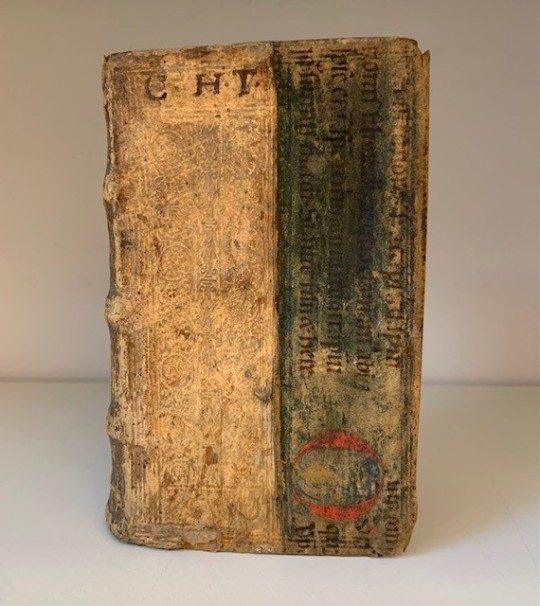


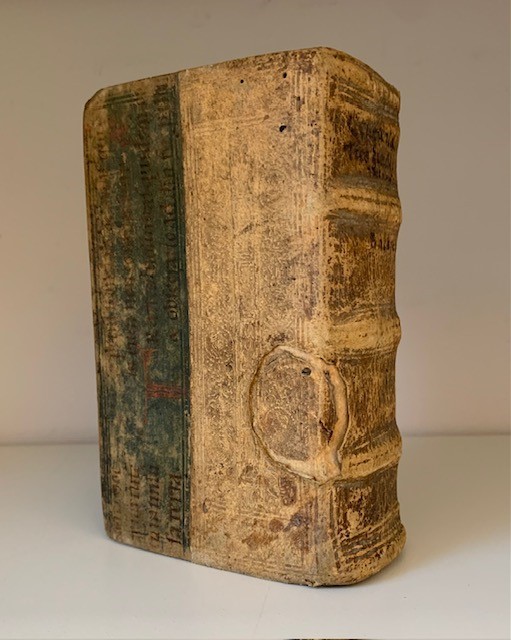

Mend and Make Do / Friday Find
This late 16th century book has the presence of a big folio, but it's actually small and portable. The binding is striking, with lots of interesting features.
In addition to the green-washed manuscript "waste" that covers the outer edges of the boards, we note that the part of the leather covering the spine and board is imperfect--with age and fluctuating humidity, the flaw that once was camouflaged with skill is now revealed.
Bachmann, Georg. Centuriae tres exercitationvm theologicarvm Complectentium doctrinam, consentientem scriptis prophetarum, apostolorum, & orthodoxae antiquitatis. VVitebergae Ex Officina Cratoniana. 1597.
47 notes
·
View notes
Text

Biblia Latina, fragment.
Ms. France or southern Flanders, early fourteenth century. Written in dark brown ink in a regular Gothic hand; text in 2 columns of 50 lines. Decoration: 11-line initial P historiated with standing figures of the Virgin and six men (one with nimbus) in colors against burnished gold background, with full-length bar border sprouting into sprays of ivy leaves (including a small dragon figure), in gold and colors; 6-line illuminated initial, with full-length bar border with sprays of ivy leaves extending along left margin, in gold and colors; 3-line illuminated initial with full-length bar border of ivy leaves extending along right margin of verso, in gold and colors; headlings in red, chapter numbers and running titles in alternating red and blue letters. This leaf is from a lectern Bible once owned by lawyer and judge Mirmellus Arnandi and left to a Dominican convent in 1450. The manuscript was sold at Parke-Bernet, New York, 30th November 1948, lot 326 to Otto F. Ege (1888-1951) who dispersed the leaves.
c.1300
Rare Book Collection, Detroit Public Library
#biblia latina#manuscript#latin#bible#ms#14th century#illuminated manuscript#medieval#middle ages#books#ege#arnandi#gothic#ms.#mss#detroit public library
28 notes
·
View notes
Text
i was looking up tips for formatting bilingual books (for example, a copy of idk the iliad with ancient greek on one side, english translation on the other), but i didn’t know the word describing this kind of format 🤔
so i was stringing together keywords like “book with two languages” and one of the results was a reddit post with someone trying to find a book that alternates between multiple languages, i.e., there are no translations, it’s it’s one text, but half of the story is in english, then the other half, or interwoven throughout, is in french or whatever
and it took strength to not suggest the hussite trilogy 🥴
#the elbow-high diaries#i need to read it a second time for the more bg characters and the politics. and i need to read it a third time for the dante.#and im chewing away at manuscript discovered in a dragon’s cave rn and#im kind of torn between trying to read it quickly (learn the content) and trying to dissect sentences and spelling (learn some vocabulary)#so you could say im half of the time trying to pay attention to words and their spelling and learn them based on the translation given#and then i get caught somewhat off guard#im like ‘ok that spelling is… that’s not polish. what is this. german.’#‘okay got it. alright [moves down page] ok now he’s just speaking latin for fun now’#i’m not complaining to be clear i just find it funny because there’s so many damn references and weaving together of different#languages cultures literary traditions canons mythologies etc.#it reminds me when i had just started reading interviews with sapkowski#and before then i had just read season of storms and i was like ‘what is all this latin how pretentious is he’#and then i read the interviews and i was like oh. that’s just how he talks#when the intellectual regis randomly quotes cicero in lotl… i can see where that came from#also again to be clear i don’t think it makes one particularly uniquely intellectual to know and use multiple languages#i think its probably what the global norm is#but what makes it funny with andrzej sapkowski is that#as dandelion said about regis: ‘(he) was an intellectual. and liked to demonstrate it’#but i think this is what i like about his writing—particularly bc i never was especially close to anyone like this irl#though i think this is maybe for the best… sometimes… intellectuals are best read and not known 😬😅
8 notes
·
View notes
Photo

ANATOMICAL FUGITIVE SHEETS OF A SKELETON: MALE FIGURE AND A FEMALE FIGURE // 1573 [woodcut, coloured | 37 x 31 cm.]
113 notes
·
View notes
Text

Medieval and Renaissance thinkers were fascinated by the moon, sun, planets, and stars. In 1474 Regiomontanus, former astrologer to King Matthias I of Hungary and Archbishop Janós Vitéz, published his work Ephemerides. It presents daily planetary positions for 32 years, and several pages of solar eclipses. One eclipse page is shown here, fol. 12v from LJS 300, a manuscript copy made in Austria, ca. 1500.
🔗:
182 notes
·
View notes
Text
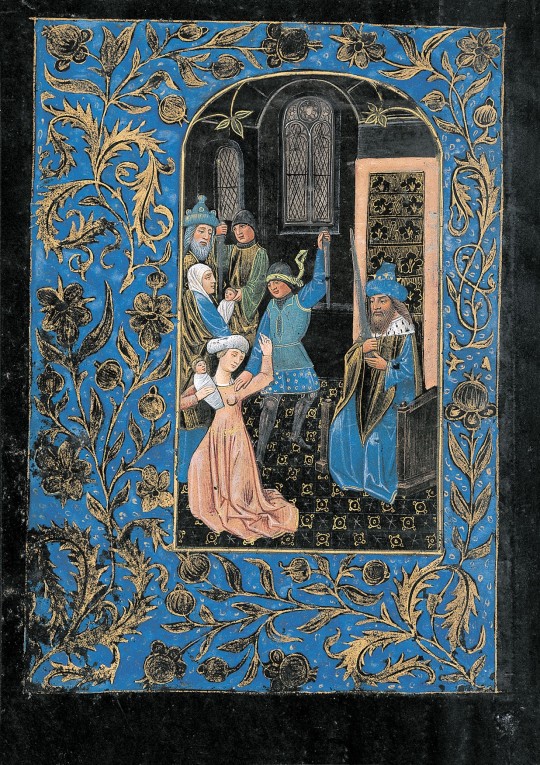
Folio 62 verso, Black Book of Hours (Morgan MS M.493)
#01 11 2023 • 48 notes#manuscript#illuminated manuscript#book of hours#Morgan MS M.493#c: flemish#y: 1400s#l: latin#t: page
217 notes
·
View notes
Text
Episode 17: Kathryn Maude on politics, the queen as evangelist, and the 11th century Encomium Emmae reginae

British Library Add MS 33241, fol. 1v
In Episode 17 of Inside My Favorite Manuscript, Dot and Lindsey chat with Kathryn Maude about the 11th century Queen Emma, who was married to and had children with both the English king Æthelred the Unready and his successor the Danish king Cnut the Great. The resulting political situation was complicated, and the Encomium Emmae reginae can help us understand the lines that Emma was attempting to walk as her sons grew into adulthood and prepared to take the throne. The text survives in two copies, the earliest one of which is British Library Add MS 33241, believed to be the copy that was presented to Queen Emma herself. Kathryn walks us through the manuscript and we talk about both the politics and the materiality of this fascinating text.
Listen here, or wherever you find your podcasts.
Below the cut are more photos and links relevant to the conversation.
British Library Add MS 33241, aka Encomium Emmae reginae (digitized online)
Folio 1v, the presentation of the book to Queen Emma, with her sons peeking out from the margin.

A close-up of folio 1v focusing on Emma and her sons.

A close-up of folio 1v focusing on the scribe presenting the book. Note that his hands are covered with a cloth. The son's hand has been added.

A close-up of folio 1v focusing on the curtains
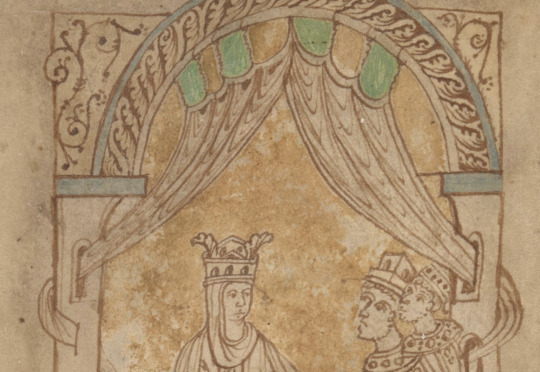
Boulogne-sur-Mer, Bibliothèque municipale, MS 11, miniature of Saint John, folio 107r

Close-up of folio 107r focusing on the curtains. Note Saint John holding the book with a cloth around it.

Copenhagen, Royal Danish Library, Acc. 2011/5, aka Courtenay Compendium, which contains the late 14th century copy of the Encomium Emmae reginae (apparently not digitized)
Doors of Durin, drawn by JRR Tolkien.

The Doors of Durin (Gates of Moria) from the Fellowship of the Ring film by Peter Jackson

Middle Aged Women in the Middle Ages, edited by Sue Niebrzydowski. Gender in the Middle Ages, Volume 7. D. S. Brewer, 2011.
Folio 18r, Sven and Cnut's names are capitalized Half Uncials while the rest of the text is a regular Carolingian script.

Folio 48r, another example. Here Emma's name is capitalized at the top.

A king pointing to the text on folio 46r - "a manicule with a king attached" - with a note written beneath in the later middle ages, probably at Saint Augustine's Abbey in Canterbury.
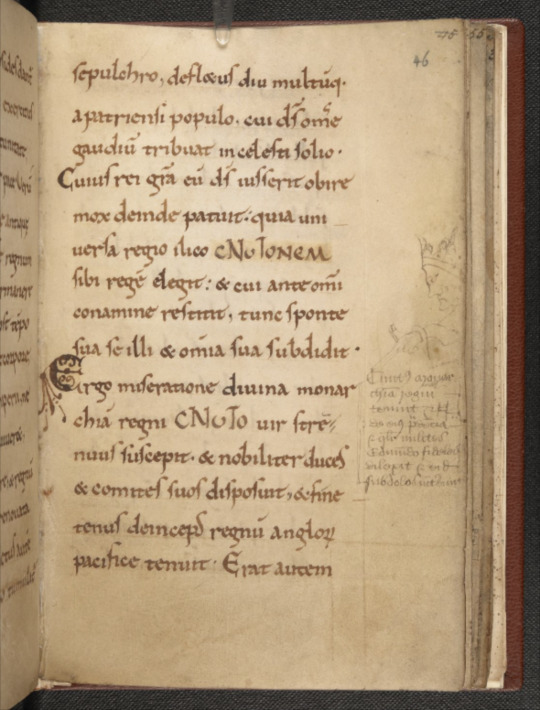
An ugly manicule (hand pointing at the text), folio 46v.

Folio 5r, a gloss in the margin.
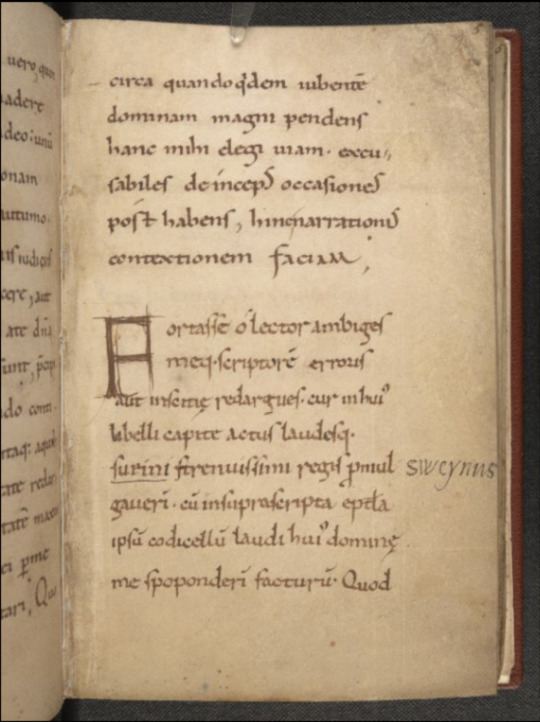
Folio 60r, an emoji in the margin of a couple of eyes to annotate the word oculi (Latin for eyes) in the text.

Close-up of the eyes.

Folio 58v, the parchment has been mended during the parchment preparation process, before the text was written.

Folio 54r, space was left for initials that were never added (the penciled M is probably contemporary but was never decorated)

Folio 2r, the first page of text, featuring a zoomorphic initial (i.e., an initial in the shape of an animal, in this case some sort of dragon and a fish eating each other) and colorful capitals.

Folio 8r, a zoomorphic initial R made of more critters eating each other. Good for a tattoo?
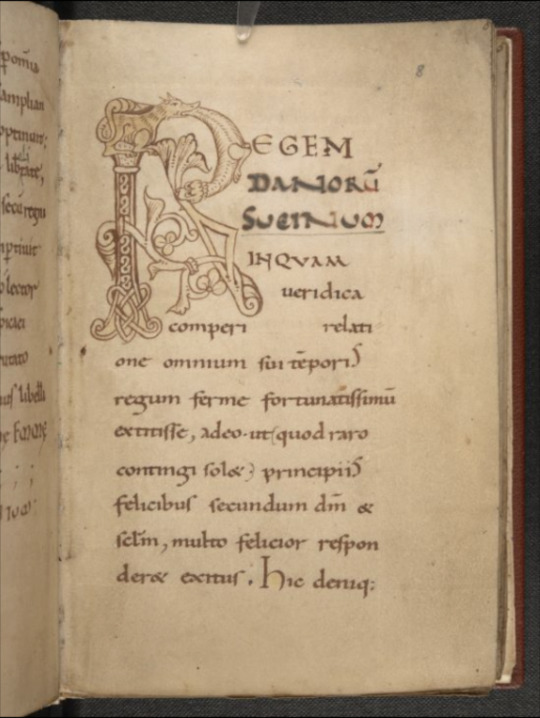
Folio 19v. "Explicit Lib[er] I" means the end of book 1, and "Incipit Secundus" means the beginning of [book] two (the second book).

Folio 50v, featuring Lindsey's ugly manicule
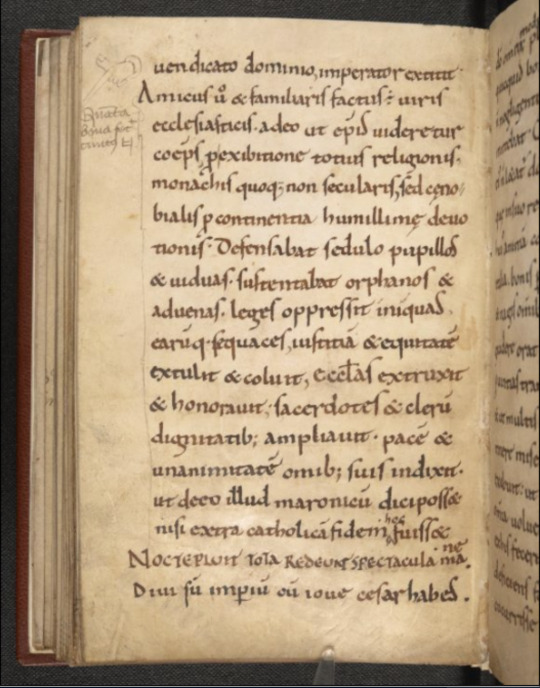
A close-up of the manicule
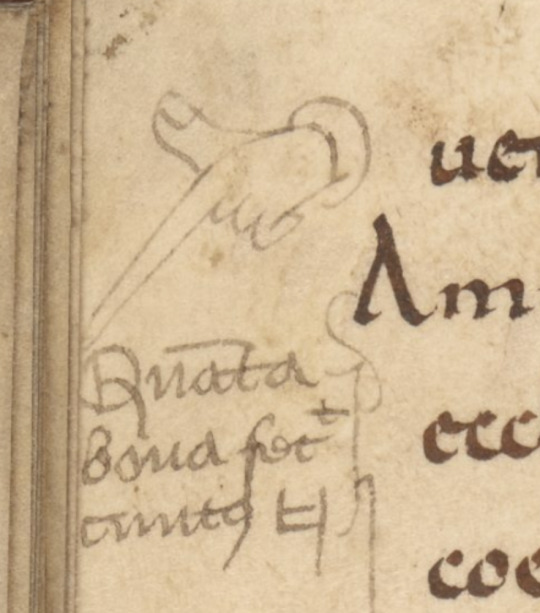
The Annunciation of Mary in Boulogne-sur-Mer, Bibliothèque municipale, MS 11
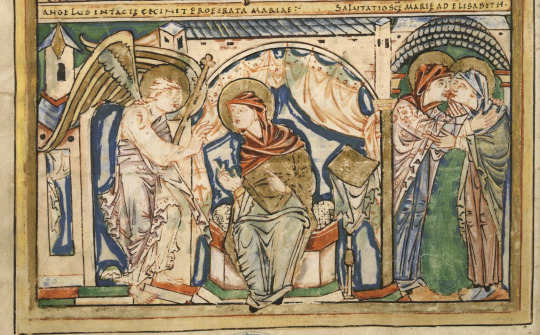
We talked to Brandon Hawk about the Vercelli Manuscript in Episode 7.
A hedgehog in the Luttrell Psalter (folio 19v)! (See it online)

"The Social Centrality of Women in Beowulf: A New Context" Dot's very first published article!
#medieval#manuscript#queen emma#medieval art#art history#early england#latin#parchment#book history#rare books#inside my favorite manuscript#podcast#imfmpod
102 notes
·
View notes
Text
i have a latin final tomorrow but i’m literally dropping the class to learn german so it feels so useless 😭😭😭
#my post#latin is a cool language to know but unfortunately i have decided that idgaf about early christianity AS AN ACADEMIC PURSUIT FOR ME#i do think it’s very cool and i love the history of it but everyone who is not me can go and look an manuscripts and the like🙏#i will be silly in the modern period god bless🙏
12 notes
·
View notes